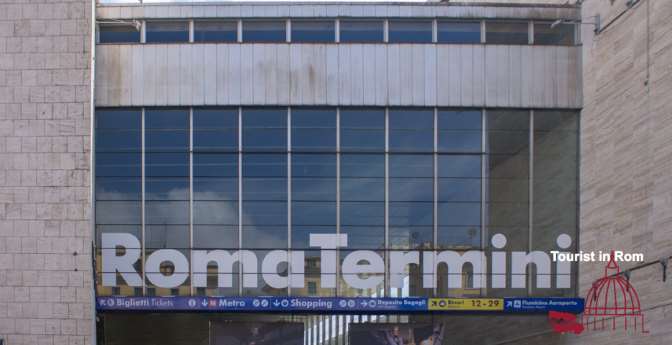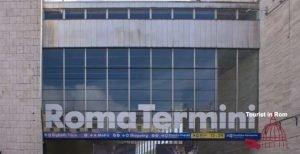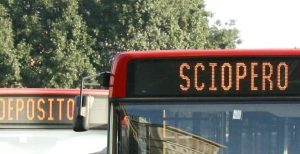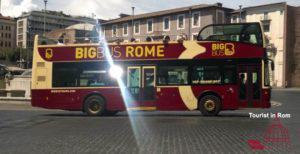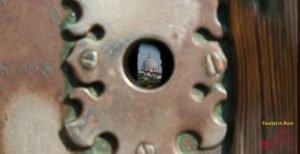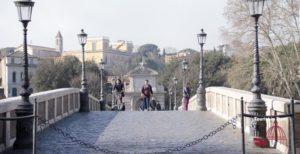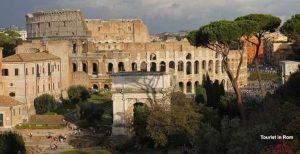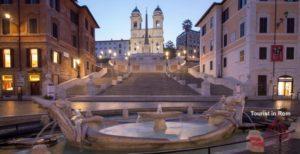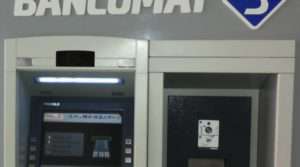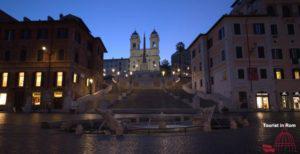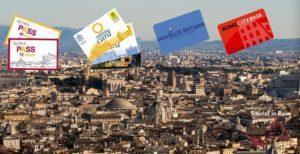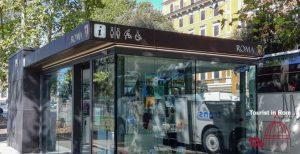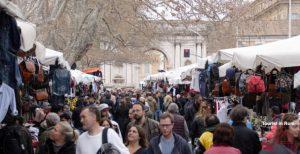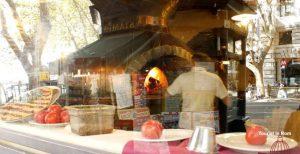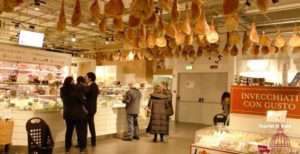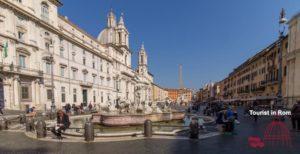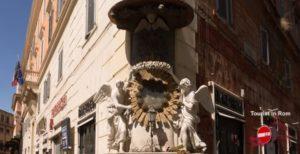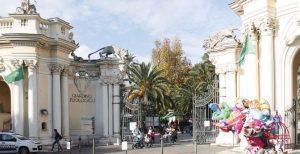Taking the train to Rome is the most environmentally friendly form of transport. Italy has a network of high-speed trains that are usually punctual to the minute.
Partner-Links helfen uns dabei, unsere Informationen kostenlos bereitzustellen. Für abgeschlossene Buchungen erhalten wir eine Provision – ohne Mehrkosten für Sie! Mehr
Partner links help us to provide our information free of charge. For completed bookings we receive a commission – at no extra cost to you! More
I link dei partner ci aiutano a fornire gratuitamente le nostre informazioni. Riceviamo una commissione per le prenotazioni completate, senza alcun costo aggiuntivo per voi! Di più
The situation of the regional connections is somewhat different. It is therefore quite possible that the last few kilometers will take longer than the express train route from Rome to Naples. The cheapest and fastest connections to Rome by train and bus can be found on Omio.
International connections to Rome
The Italian high-speed network is well connected with international connections. There are connections from Germany via Switzerland to Milan. The Austrian OEBB connects Bolzano via Innsbruck and Salzburg with Vienna as well as Vienna and Venice with its Railjets. From Paris there are connections by TGV to Turin and Milan. You can reach Rome at high speed from Turin, Milan, Bolzano and Venice. Connections can be found on Omio.
The comfortable Austrian night trains Nightjet connect Rome with Vienna and Munich.
High speed trains
The high speed trains (alta velocità = AV) connect the centers of the Italian continent very efficiently.

The network extends from Bolzano, Venice, Milan and Turin via Bologna to Rome and on to Naples and Salerno. Most routes are approved for speeds of 250 km / h or 300 km / h. There is hardly any air traffic from Milan to Rome, because the connections from city center to city center are faster by train.
In Rome, Termini, Tiburtina and Fiumicino Airport stations (for connections to Florence and Naples) are connected to the high-speed network.

The high-speed trains of the Italian railways are divided into the train families Frecciarossa and Frecciargento. The “Red Arrows” include the types ETR500 and the new ETR1000, the “Silver Arrows” consist of older series. In particular, the Internet connections are better in the Frecciarossa than in the Frecciargento.
There is also the private operator Italo. The trains are a little shorter and lighter than the “Frecce”. Italo also offers good service and is often cheaper than the “Frecce”. Connections can be found on Omio.
Regional trains
You can use regional connections with train tickets or with regional Metrebus tickets. With a three-zone ticket, you can travel from Rome to Tivoli and Castel Gandolfo, for example.
Within Rome you can use the trains with the normal city ticket, for example from Ostiense or Trastevere to the San Pietro station at the Vatican.
The exception is the Leonardo Express from Fiumicino Airport to Rome Termini. You need your own tickets for this train. They are valid for one trip on the day booked.
Buy train tickets
The high-speed trains are like the plane. You can only use it with a reservation and the later you book, the more expensive it gets. The trains offer four classes. At Trenitalia they are called Standard, Premium, Business and Executive, at Italo Smart, Comfort, Prima and Club Executive.
The other trains have one or two classes.
We generally recommend booking on the Internet. Booking the high-speed trains on or just before the day of travel is extremely expensive, if you can even find a seat. For the other trains you often have to wait long at the ticket offices or at the machines.
With the high-speed trains, it is not possible to rebook the low cost tariffs, with the regional trains you can take the next train within four hours if you missed the train you booked. With the Leonardo Express, tickets are valid for one trip on the day booked, regardless of the time.
Current train information
You can find up-to-date information on trains and delays on the website www.viaggiatreno.it. You can search for information for a specific station or for a train number. The page gives you information about the current departure time and the platform as well as the connections at the transfer stations.
Railway stations in Rome
Termini & Tiburtina stations are the hubs of the Italian high-speed rail network in Rome. Termini Central Station provides a connection to numerous regional trains as well as to the metro and city buses. The modern Tiburtina station is a through station and some high-speed trains on the north-south axis only stop here. At Tiburtina, the transition to Metro B is possible as well as city connections to the northeast of Rome.
The railway stations Ostiense, with the transition to the local railway to Ostia and the metro, and Trastevere, where you change between the lines to Fiumicino Airport, the Vatican, the railway line to Viterbo and the railway line to Civitavecchia, Pisa and Genoa, are of regional importance.
Roma Termini
Termini Central Station is a very spacious terminus with 24 main tracks and five set-back tracks for regional traffic on the left, at Via Giolitti.
There are long ways especially when switching from long-distance connections to regional traffic. Approximately in the middle of the platforms you can find an underpass, which you can use to shorten the routes considerably.
At the head of the station there is a shopping gallery on three floors as well as the transition to the metro lines in the basement. On the left side of the train station, at Via Giolitti, is a large area with bars, restaurants and street food.
In front of the head of the station is the taxi stand and a bus station for the city lines.
The SIT Bus airport shuttle to Ciampino and Fiumicino leaves in front of the train station on the right-hand side from via Marsala no.5.
At Termini station there are always long queues at the ticket offices and in the luggage storage area.
Opposite the train station is private luggage storage which is faster and cheaper.
You can eat very well in Rome. This also applies to Termini station.

On the left side of the station, on the Via Giolitti side, there is a large restaurant area in the middle of the station. It is called “Mercato Centrale”. The Mercato Centrale has restaurants and a large street food area where the best names in Rome compete for guests. Here you can get pizza, hamburgers, fish specialties, international beers, desserts and ice cream, among other things. If you are at the Termini station and want to eat something, the Mercato Centrale is recommended.
Tiburtina train station
The station was completely renovated a few years ago and serves as a stop for high-speed trains on the Naples – Florence axis. As the trains do not have to enter Termini main station, they save a lot of time on the north-south axis. Metro line B crosses at Tiburtina station and it serves as the starting point for numerous regional bus routes. From Fiumicino airport you can get to Tiburtina train station with the regional line FL1 towards Fara Sabina.
Trastevere train station
If you are coming from Fiumicino Airport, you can change trains at Trastevere train station in the direction of Civitavecchia – Pisa – Genoa and in the direction of Viterbo. The trains also stop at St. Peter’s Basilica at Roma San Pietro station.
At Trastevere train station, tram line 8 goes to the central Piazza Venezia and tram line 3 to the Colosseum and on, past the basilicas of St. John, Holy Cross in Jerusalem and St. Lawrence, to the zoo.
Ostiense train station
Ostiense train station is also on line FL1 from Fiumicino Airport in the direction of Fara Sabina. The train station is connected to the Piramide metro station on line B. The trains to Ostia also depart from there.

Opposite the train station and directly accessible through an underpass is the luxury supermarket “Eataly” with selected groceries and various dining options from snacks to high-quality restaurants.
Long-distance buses
Long-distance buses are an inexpensive way to get to Rome. You can find connections and prices on Omio. The main long-distance bus station is Rome Tiburtina. Long-distance buses also go to Fiumicino and Ciampino airports.
Rome Tiburtina bus station
The Tibus Rome Tiburtina bus station is located opposite the Tiburtina train and metro station (Tibus website). The Flixbus and many lines go here in the direction of the Apennines, the Adriatic Sea and all of Italy ![]() . 300 meters further is a Lidl supermarket in Via Lega Lombarda 32.
. 300 meters further is a Lidl supermarket in Via Lega Lombarda 32.
Regional buses
The regional bus routes are called COTRAL (website). The buses go in all directions and there are different departure points. The main regional bus stations are:
- Laurentina metro station (southbound)
- Anagnina metro station (southbound)
- Metro station Ponte Mammolo (eastbound)
- Cornelia metro station (north-west)
- Saxa Rubra (northbound) on the Flaminio – Viterbo train line and bus 32
